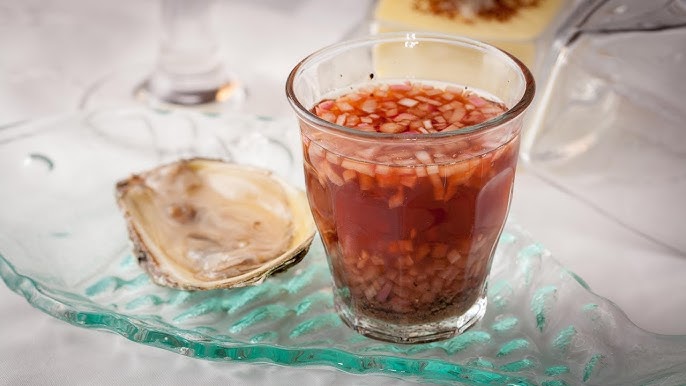Mignonette Sauce Recipe: If you’ve ever enjoyed a platter of fresh oysters at a fine dining restaurant, chances are you’ve encountered a tiny ramekin filled with a tangy, flavorful sauce known as mignonette. This classic French condiment has been served alongside oysters for centuries, and it remains a timeless pairing today. But what exactly is mignonette sauce, and why does it hold such a special place in the world of seafood dining?
At its core, mignonette sauce is a simple mixture of vinegar, minced shallots, and freshly cracked black pepper. But don’t let its simplicity fool you—this sauce is a flavor powerhouse. The sharpness of the vinegar, the mild sweetness of the shallots, and the spicy bite of pepper come together to create a perfect balance that enhances the natural brininess of oysters. It’s refreshing, zesty, and elevates raw oysters from good to unforgettable.
Think of mignonette as the sophisticated cousin of cocktail sauce. While cocktail sauce brings bold and punchy flavors with ketchup and horseradish, mignonette is elegant, refined, and designed to highlight rather than mask the delicate taste of fresh shellfish. Whether you’re hosting a dinner party, enjoying a romantic seafood date night, or simply want to bring a restaurant-quality touch to your oysters at home, mastering mignonette sauce is a skill worth learning.
So, in this guide, we’ll break down the exact ingredients you need, step-by-step instructions for making it, and even some creative variations you can try to impress your guests. By the end, you’ll be able to whip up this French classic like a professional chef.
Ingredients You’ll Need
Making mignonette sauce doesn’t require an overflowing pantry or fancy ingredients. In fact, you’ll probably find that most of the essentials are already in your kitchen. The key here is quality over quantity. Since there are so few components, each one plays an important role in the final flavor.
Core Ingredients of a Classic Mignonette
- Shallots: These are the star of the sauce. Shallots have a mild onion flavor with a touch of sweetness, which makes them perfect for balancing the acidity of vinegar. Always go for fresh, firm shallots and mince them as finely as possible for the best texture.
- Vinegar: The soul of the sauce. Traditional recipes often use red wine vinegar, but champagne vinegar is another popular choice for a lighter, more delicate taste.
- Black Pepper: Freshly cracked black pepper is essential. Pre-ground pepper just won’t deliver the same punch. The coarsely ground peppercorns add both spice and texture to the sauce.
Optional Add-Ins for Extra Flavor
If you’re feeling adventurous, you can add a little twist to your mignonette without straying too far from tradition. Some great add-ins include:
- A splash of white wine for depth
- Fresh herbs like parsley or tarragon for brightness
- Lemon zest or a squeeze of juice for a citrus kick
- A pinch of sugar or honey if you prefer to mellow out the sharp vinegar bite
Choosing the Best Vinegar for Your Sauce
The choice of vinegar can completely change the personality of your mignonette.
- Red Wine Vinegar: Bold and slightly fruity, perfect if you want a more robust sauce.
- Champagne Vinegar: Light, crisp, and elegant, often the favorite for special occasions.
- White Wine Vinegar: Mild and versatile, great for experimenting with other flavors.
When selecting vinegar, always aim for high-quality brands. Since vinegar is the backbone of the sauce, a cheap, overly harsh vinegar can throw off the delicate balance.
Essential Kitchen Tools
While mignonette sauce doesn’t require high-end kitchen gadgets, a few basic tools will make your preparation easier and ensure a polished final product.
What You’ll Need for Preparation
- Sharp Chef’s Knife: Essential for mincing shallots finely.
- Cutting Board: Preferably wooden or plastic, easy to clean after cutting onions and shallots.
- Measuring Spoons: Accuracy is key when balancing vinegar and pepper.
- Mixing Bowl: A small glass or ceramic bowl works best. Avoid plastic, as vinegar can sometimes react with it.
- Spoon or Whisk: For mixing ingredients evenly.
- Small Ramekins or Sauce Dishes: Perfect for serving mignonette alongside oysters.
Tips for Selecting the Right Tools
- Always use a sharp knife. Dull knives bruise shallots and release too much sulfur, making the flavor harsh.
- If you don’t own a pepper grinder, invest in one. Freshly cracked pepper is a game-changer.
- Chill your serving ramekins in the fridge before filling them with mignonette. This keeps the sauce extra refreshing when served with oysters.
Step-by-Step Guide to Making Mignonette Sauce
Now that we’ve gathered all the ingredients and tools, it’s time to get into the fun part—making the sauce. Mignonette might be simple, but attention to detail can take it from ordinary to extraordinary. Let’s go step by step.
Step 1 – Prepping the Shallots
The foundation of any good mignonette is finely minced shallots. Take your time here; precision matters. Peel the shallots, slice them in half lengthwise, and then mince them as finely as possible. The smaller the pieces, the better they’ll blend into the sauce. Large chunks can be overpowering and unpleasant when paired with oysters.
Think of shallots as the gentle whisper in your sauce. You want their presence to be noticeable but not overwhelming. Aim for uniform pieces, which also helps with even flavor distribution.
Step 2 – Mixing Vinegar and Seasonings
Next, pour your chosen vinegar into a small bowl. For a traditional recipe, start with about ½ cup of red wine vinegar. Add a generous pinch of freshly cracked black pepper—don’t be afraid to go bold here. The spice is what makes the sauce dance on your palate.
If you’re adding extras like a splash of white wine, lemon zest, or herbs, now’s the time to mix them in. Stir gently to combine.
Step 3 – Blending Everything Together
Add the minced shallots into your vinegar mixture. Stir well to ensure everything is evenly distributed. At this stage, your sauce will look simple, but the flavors need time to mingle before reaching their full potential.
Step 4 – Letting the Sauce Rest for Flavor
Here’s the secret: let your mignonette rest. Cover the bowl with plastic wrap and refrigerate it for at least 30 minutes before serving. This allows the shallots to soften slightly and the flavors to meld beautifully. The longer it sits, the better it tastes—though ideally, it’s best enjoyed within a few hours of preparation.
Step 5 – Serving with Fresh Oysters
When it’s time to serve, spoon the chilled mignonette into small ramekins and place them on the oyster platter. Each guest can spoon a small amount over their oyster before slurping. The tangy sauce will cut through the briny richness of the oysters, creating a flavor explosion with every bite.
Variations of Mignonette Sauce
One of the reasons mignonette sauce has remained such a timeless classic is its versatility. While the traditional recipe is a must-know, it’s also incredibly adaptable. By playing with different vinegars, spices, or even adding unique ingredients, you can tailor the sauce to your personal preferences or to match a specific occasion. Let’s explore some of the most popular and delicious variations.
Classic French Style
The French original keeps things beautifully simple: red wine vinegar, finely minced shallots, and cracked black pepper. This version highlights the purity of flavor and is perfect for oyster purists who want tradition on their plate. The richness of red wine vinegar complements the salty sweetness of oysters, making this the go-to recipe for many chefs.
If you’re serving oysters at a dinner party, the classic French style will always impress. It has a rustic charm, a connection to history, and a balance that never fails.
Citrus-Infused Mignonette
For a refreshing twist, add a citrus element to your mignonette. Lemon zest, orange peel, or even a splash of yuzu juice can brighten the sauce, giving it a crisp and tangy flavor profile. This version works particularly well with sweeter oyster varieties like Kumamotos or Pacific oysters.
Imagine taking a bite of an oyster topped with citrus-infused mignonette—it’s like a burst of sunshine on your palate, cutting through the briny richness with a zing of freshness.
Spicy Pepper Mignonette
If you like a little heat, this variation is for you. Along with black pepper, try adding freshly ground white pepper, crushed red pepper flakes, or even a few slices of jalapeño for a subtle kick.
This version pairs especially well with larger, meatier oysters that can stand up to bolder flavors. The spice brings warmth to each bite, without overpowering the oyster’s delicate essence.
Red Wine Vinegar vs. Champagne Vinegar
Your choice of vinegar can completely transform your sauce. Red wine vinegar gives depth and intensity, while champagne vinegar delivers elegance and subtlety. For a dinner with friends, red wine vinegar is comforting and familiar. But for a celebratory occasion—say New Year’s Eve or an anniversary—champagne vinegar feels elevated, almost luxurious.
If you’re unsure which to choose, make both! Offering two types of mignonette on the same platter not only impresses guests but also sparks conversation as they compare the flavors.
How to Serve Mignonette Sauce
The sauce is ready, but presentation matters just as much as preparation. Serving mignonette correctly enhances the overall experience and brings that fine-dining touch right to your table.
Pairing with Fresh Oysters
Oysters and mignonette are a match made in culinary heaven. To serve them properly:
- Arrange freshly shucked oysters on a large platter filled with crushed ice.
- Place small ramekins of mignonette in the center, ensuring they stay chilled.
- Provide small spoons so guests can drizzle the sauce onto their oysters.
Keep in mind that mignonette is meant to complement, not smother, the oyster. A half teaspoon is usually enough to highlight the natural flavors without overwhelming them.
Presentation Tips for an Elegant Table
- Chill everything: Keep ramekins and oyster platters cold to maintain freshness.
- Garnish with style: A few sprigs of parsley, lemon wedges, or edible flowers can elevate the visual appeal.
- Serve with accompaniments: A crisp glass of white wine, champagne, or dry rosé pairs beautifully with oysters and mignonette.
Think of it this way: oysters are like jewels of the sea, and mignonette is their crown. Serve them with care, and your guests will feel like royalty.
Storage and Shelf Life
Even though mignonette sauce is simple, it’s important to know how to store it properly to maintain freshness and safety.
How Long Can You Keep Mignonette?
Thanks to its vinegar base, mignonette has a surprisingly good shelf life. In an airtight container stored in the refrigerator, it can last up to 5–7 days. Over time, the shallots will soften and the flavors will deepen, which some people even prefer.
However, for the freshest taste and best texture, it’s recommended to consume the sauce within 48 hours of preparation. Beyond that, the shallots may become too soft, losing their crisp bite.
Best Storage Practices
- Always store mignonette in a glass container rather than plastic, as vinegar can sometimes absorb unwanted flavors from plastic.
- Keep it tightly covered to prevent the shallots from oxidizing or the vinegar from losing its brightness.
- Refrigerate immediately after preparing and avoid leaving it at room temperature for extended periods.
A simple trick? Make the sauce the morning of your event, let it rest in the fridge for a few hours, and it’ll be perfect by the time your oysters are ready to serve.
Common Mistakes to Avoid
Even though mignonette sauce is beginner-friendly, a few common errors can throw off the balance of flavors. Avoiding these pitfalls ensures your sauce tastes as good as it looks.
Overpowering Flavors
One of the biggest mistakes is using too much vinegar or overloading the sauce with pepper. Remember, oysters are delicate and subtle—the sauce should enhance, not dominate. Use moderation and taste as you go.
Wrong Vinegar Choices
Not all vinegars are created equal. Avoid strong, harsh vinegars like distilled white vinegar, which can be too sharp and unpleasant with oysters. Instead, stick to wine-based or champagne vinegar for a smoother, more refined taste.
Serving It Too Soon
Mignonette needs time to rest. Serving it immediately after mixing won’t give the shallots enough time to release their flavor into the vinegar. Let it sit for at least 30 minutes in the fridge before serving.
Think of it like wine—it gets better with a little patience.
Health Benefits of Mignonette Sauce
At first glance, mignonette sauce might just seem like a simple flavor enhancer for oysters, but it actually comes with its own set of health benefits. Because it’s made from wholesome, natural ingredients, you can enjoy it guilt-free while adding a little extra nutrition to your seafood platter.
Low-Calorie Flavor Booster
One of the best things about mignonette is that it’s incredibly light. Unlike creamy dressings or butter-based sauces, mignonette is vinegar-based, which means it contains very few calories. A spoonful of this sauce adds bold flavor without piling on fats or sugars. If you’re watching your weight or simply looking for healthier ways to enjoy food, this is a win-win.
Pairing oysters with mignonette is particularly great for those on a clean eating journey. Instead of masking oysters with heavy toppings, you’re enhancing them with a sauce that’s fresh, light, and completely guilt-free.
Nutritional Benefits of Shallots and Vinegar
The ingredients themselves bring small but significant nutritional perks:
- Shallots: These are rich in antioxidants, vitamin C, and minerals. They’re known for supporting heart health and boosting immunity. Plus, they add a subtle sweetness that balances vinegar beautifully.
- Vinegar: Often praised for its digestive benefits, vinegar may help regulate blood sugar levels and promote gut health. It also has antimicrobial properties, which can contribute to food safety.
- Black Pepper: Not just a spice, black pepper is known for aiding digestion and improving nutrient absorption.
Together, these simple ingredients not only deliver flavor but also add a dose of wellness to your dining experience. It’s proof that healthy eating doesn’t have to be bland—it can be sophisticated and delicious.
FAQs about Mignonette Sauce Recipe
Let’s tackle some of the most common questions people have about this classic sauce.
1. Can I make mignonette sauce ahead of time?
Yes! In fact, it tastes better if you prepare it a few hours in advance. Just store it in the refrigerator and let the flavors meld together.
2. What’s the best vinegar to use for mignonette?
It depends on your taste preference. Red wine vinegar offers a bolder profile, while champagne vinegar delivers a delicate, refined flavor. White wine vinegar is a versatile middle ground.
3. Do I have to use shallots, or can I substitute onions?
Shallots are preferred because of their mild, sweet taste. Onions can be too sharp and overpowering, but if you must substitute, go for a very small amount of red onion.
4. Can I serve mignonette with seafood other than oysters?
Absolutely! While it’s traditionally paired with oysters, it also works well with clams, mussels, or even as a tangy drizzle over grilled fish.
5. Is mignonette sauce safe for everyone to eat?
Yes, the sauce itself is safe. However, remember that it’s usually served with raw oysters, which aren’t recommended for pregnant women, young children, or people with compromised immune systems.
Conclusion
By following this step-by-step guide, you’ll not only master the classic recipe but also gain the confidence to serve oysters like a pro at your next gathering. From choosing the right vinegar to presenting it elegantly on a bed of ice, every detail matters. And the best part? This sauce is as healthy as it is delicious.
So next time you’re planning a seafood feast, don’t skip the mignonette. It’s the finishing touch that turns oysters into an unforgettable experience.



